Please Don’t Make Banana Peel Compost Tea Fertilizer For Houseplants
Always on the hunt to reduce food waste, I saw a bunch of people share about banana peel compost tea (or liquid fertilizer) on social media. Intrigued by this little food waste reduction experiment, I tried it, and I will never do it again. Read on for more about my disappointing experience with this trendy soil amendment and why I think there are so many better alternatives.
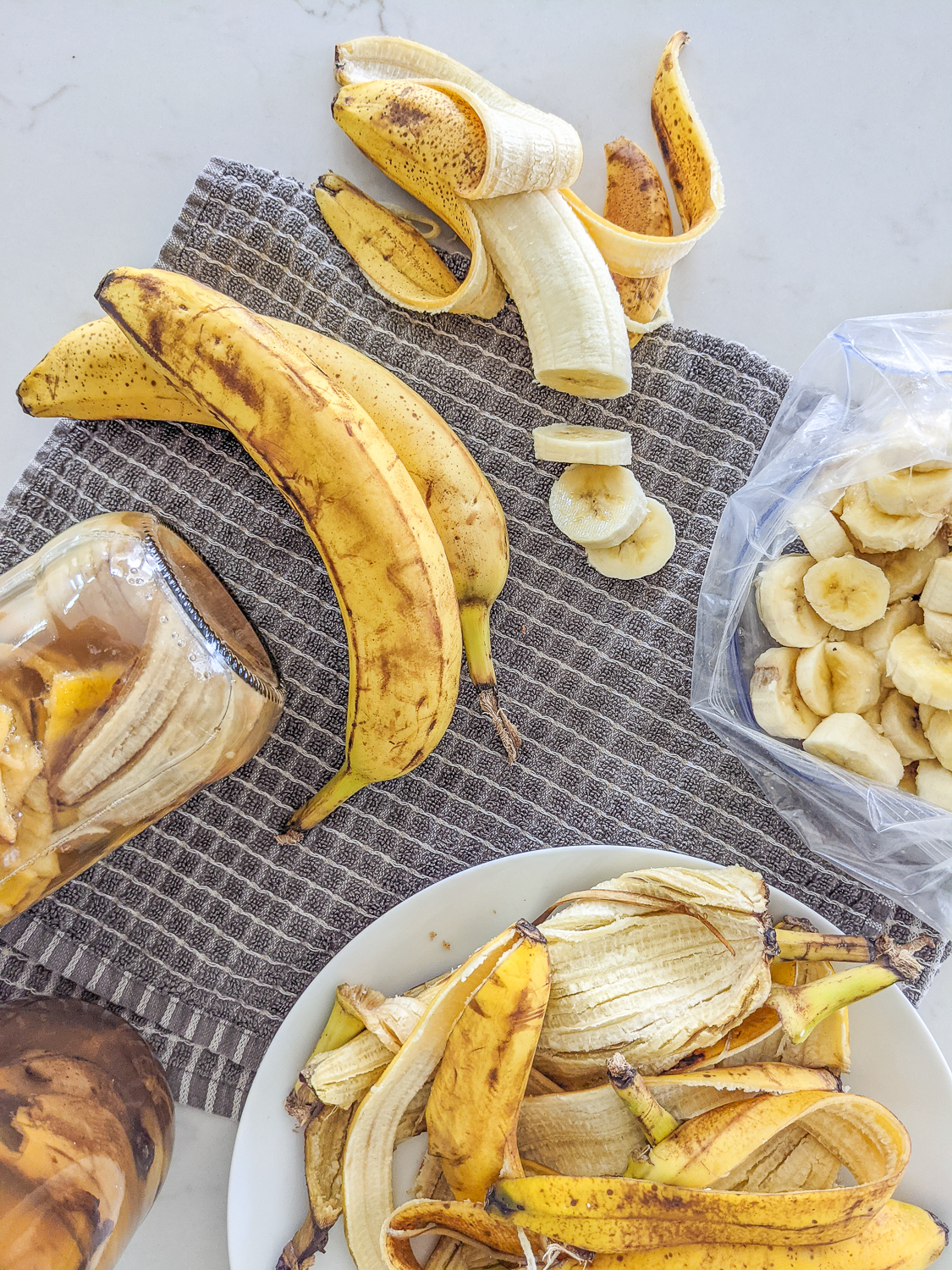
A few months ago, we bought this Vitamix blender and have been eating lots of smoothies for breakfast. This mango and banana green smoothie is my favorite, and I make some version of it nearly every morning. As a result, we have an excessive number of banana peels piling up in our compost bucket.
I know they will go to good use in my compost pile, but I have a growing collection of indoor houseplants that I wanted to feed too. Enter banana peel compost tea fertilizer (a liquid soil amendment). If banana peels make a compost bin happy, surely they would make soil happy, right?
Nope! Stop right there. Please skip the banana peel compost tea fertilizer (at least the simplified version that’s popular on social media). Let me explain.
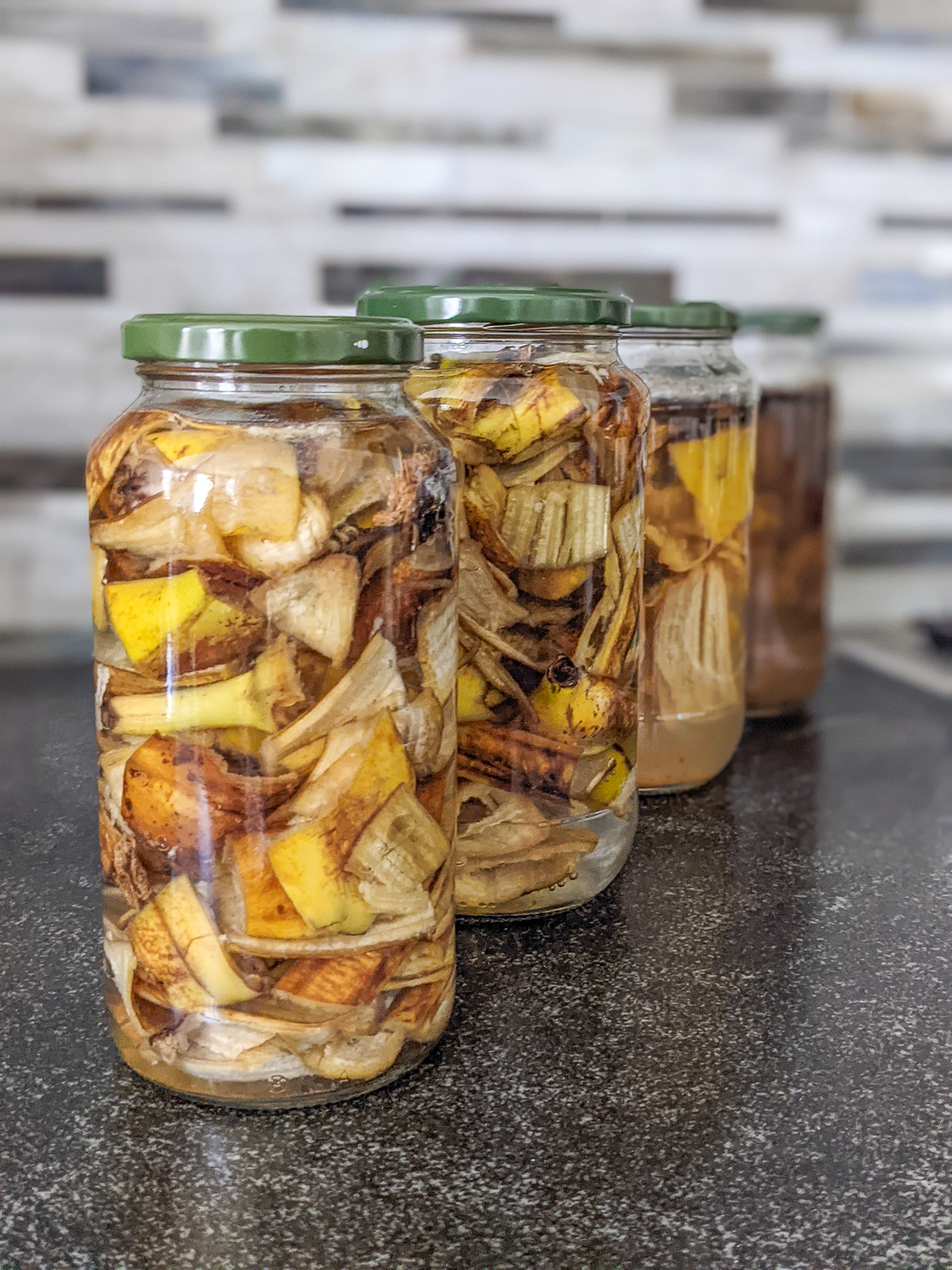
Banana Peel Compost Tea Experiment Planning
A couple of months ago, with plenty of banana peels at my disposal, I decided to try making banana peel tea fertilizer for some of the plants in my house. It was popular on social media, after all, so why not try it? (Note to self: social media popularity alone is not a good reason to try something new…)
I’m a houseplant newbie. I dove headfirst into houseplant territory just about a year ago with my Succulent Studios subscription and have been steadily adding to my indoor garden. But I’m far from an expert on the deep science of soil, so a bit of due diligence was in order.
I did a little research to ensure I would not burn the roots of my plants or cause other damage with my banana peel fertilizer experiment. Admittedly, I didn’t dig that deep into the archives of the internet, but I didn’t see any immediate red flags. Planning complete.
What did I have to lose besides a couple of small houseplants that became my experimental ground?
How To Make Banana Compost Tea Fertilizer
After cutting up a few brown bananas to put in the freezer for smoothies, I chopped up the peels and shoved them into repurposed glass jars. I have (probably) too many repurposed glass jars, so I made a few batches of this supposedly miraculous liquid fertilizer and perfected my patience.
The trendy banana peel compost tea fertilizer is a cinch to make (which is probably why it’s so popular on social media). The bright yellow peels pop on a pretty Instagram feed too! It all just makes social media sense. I’ve included the simple recipe at the bottom of the post, but it goes like this:
Ingredients + Materials
- 3-4 banana peels
- Quart-sized jar – we use repurposed pasta jars
- Water – to fill the jar
Step-by-Step Instructions
- Add chopped banana peels to the jar.
- Fill the jar to the top with water, enough to cover the banana peels.
- Close the jar and allow it to rest for a few days or a week.
- Remove the peels and water plants with the banana peel tea fertilizer.
- Watch magic happen!
Because I got carried away with life, I let it sit for a couple of weeks in the jar. Then I watered a few of my houseplants with the fancy water and waited.
Update: Since initially posting this, I’ve received several (mostly well-intentioned) emails suggesting the recipe is incomplete. Specifically, readers have recommended using aeration tools and/or straining the compost tea to prevent any fruit chunks from ending up in the soil.
If you choose to make banana peel compost tea, I assume these additional steps would create a better final product. That being said, I’m still not sold this is the best way to fertilize plants (which I explain in more detail below).
Furthermore, I used the recipe above to test the common, simplified version I’ve been seeing on social media. I included the recipe so you can see what didn’t work, and then decide for yourself if another banana peel compost tea recipe might be better.
In my opinion, as a regular ol’ lady on the Internet, this simplified version doesn’t seem to work. But telling you my recipe didn’t work without actually sharing what I did doesn’t seem particularly useful. So… recipe details are included.
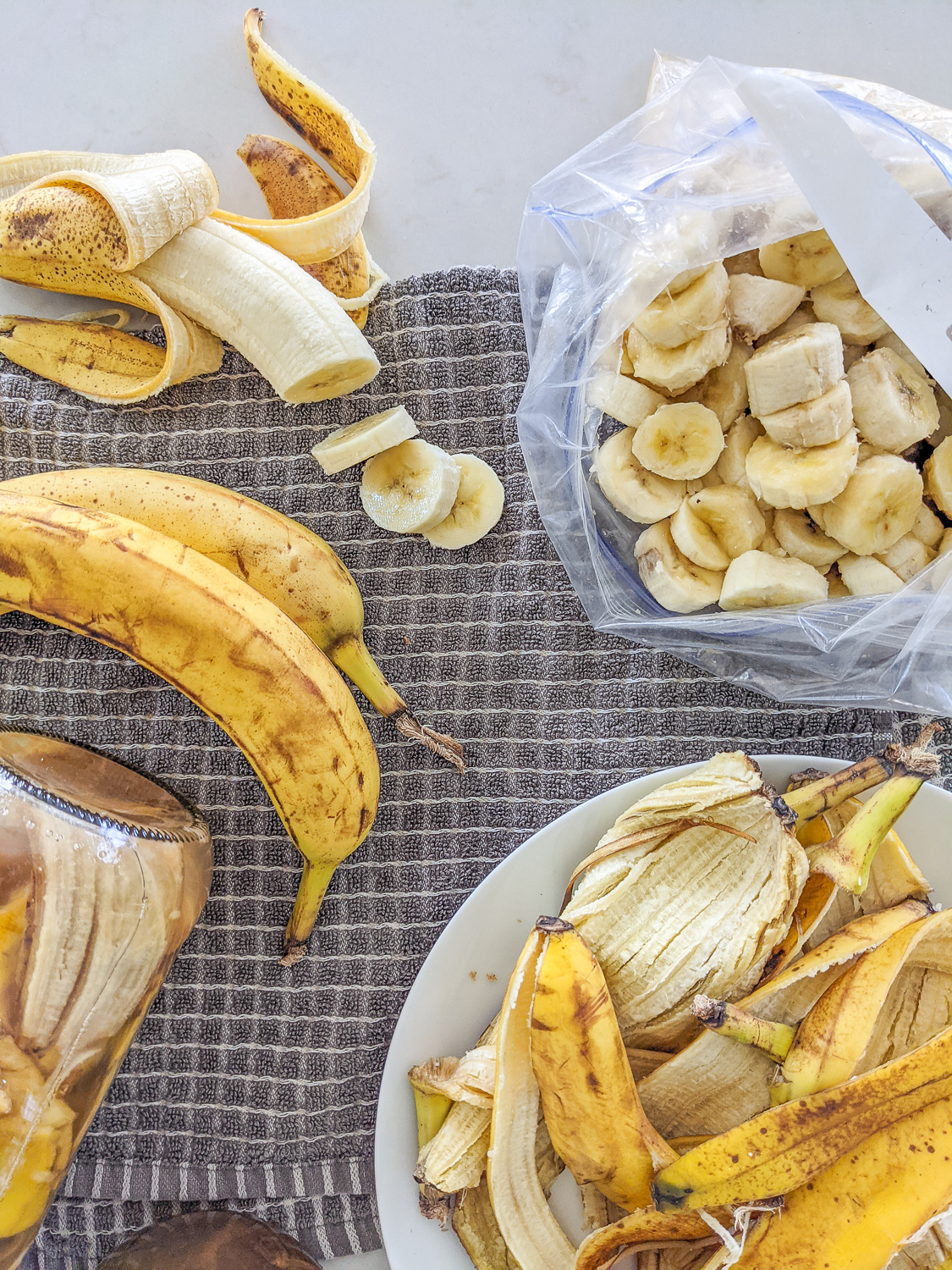
Banana Peel Compost Tea Epic Fail
Things started to get murky pretty quickly.
As soon as I opened the jars, I didn’t have a warm and fuzzy feeling about the banana peel tea fertilizer. It smelled suspiciously sweet (like it would attract bugs), and the whole process was kind of messy.
Immediately, I noticed stains on several of the leaves of my plants. While the stains appear to be permanent, they don’t seem to have caused harm. But who wants to stain their beautiful plants when they water them?
Also, the soil continued to smell like a combination of sweet and somewhat rotting banana peels for many days after watering it. This made me nervous about the lasting effects.
Within just a few days, the real problem began. I started noticing little gnats flying around the soil. I’ve had several plants in my home for over a year. I’ve had no persistent issues with bugs in my home… until this banana compost tea situation.
Hindsight is 20/20, but I soon realized that I forgot to research other potential side effects. I started to dig a little deeper into the science behind why banana compost tea might work or not work and found some opinions about its lack of efficacy that were quite compelling.
I threw out the remaining banana peel compost tea and continued watering the plants at regular intervals with tap water. Over the course of a couple of months, however, the fungus gnat problem grew, and they began spreading through the rest of our house.
Little gnats flew into our faces while on Zoom conference calls. They buzzed in our ears as we fell asleep at night. They even showed up in our bathroom, and are flying in my face as I write this post. It’s gross! And now I don’t know how to get rid of them.
After some further research, I’ve come to believe that the sweet remnants of rotting bananas with which I watered the soil attracted the fungus gnats and became food for their families. They continue to lay eggs in the soil, and I’ve got quite the project ahead of me to stop the reproduction cycle to get these guys out of my house!
Update: We eventually resolved our fungus gnat issue. First, I watered the plants as infrequently as possible (without killing them) to limit the moisture in the soil that attracted the gnats. I also sprinkled food-grade Diatomaceous Earth on the soil of each plant to help get rid of fungus gnats. Many readers recommended it, and it worked quite well.
Then, I placed these glue board traps near the plants. They caught a lot of fungus gnats to slow the reproduction cycle. Be careful with these traps. They are incredibly sticky, as you can imagine, so keep them away from children and other small animals.
Why Would Banana Compost Tea Fertilizer Even Work?
In retrospect, and after doing quite a bit more research, I applied my knowledge of composting to this experiment. I’m not a scientist or compost expert, so I’m not purporting to have all the definitive answers on banana peel compost tea. I’ve never done any replicable or peer-reviewed research on which to base formal conclusions about the efficacy of banana peel compost tea.
But the more I think about how it might work and why it might work, the more I think it’s relatively useless. I think banana peel compost is only popular because it looks pretty on Pinterest and Instagram.
P.S. Banana peel compost tea is trending on Pinterest this year, so banana-fanatics beware.
Additionally, I followed up my experience by reading the book Compost Teas For The Organic Grower by Eric Fisher. Despite going into great detail about many types of compost teas, different aeration systems and recipes, and a whole lot more information about why various types of compost tea are best for certain gardening situations, the author never mentions banana peel compost tea. In fact, he doesn’t even mention bananas in the book as far as I recall. If banana peel compost tea is so great, wouldn’t it have been in a book like this?
How Does Banana Peel Tea Fertilizer Help Plants Thrive If It Even Works?
The lore goes that bananas are good for plants because they provide a lot of potassium, and potassium is an essential element for plant growth. Potassium helps plants grow strong roots, use water effectively, and resist drought. It also enhances fruits and vegetables, so it can be particularly helpful for growing edible gardens and food crops.
If soluble potassium (or potassium that plants can access through water) is deficient in soil, plants may experience stunted growth or other symptomatic issues that cause plants to be weak and more vulnerable to unfavorable conditions.
Did you know that potassium is a mobile nutrient, meaning a plant can reallocate potassium throughout itself? As a result, older (lower) leaves on a plant tend to show signs of potassium deficiency before the younger (higher) leaves because the plant sends what little potassium it has to the younger, developing leaves. Isn’t this a neat function of how plants look out for themselves and their future health? I digress…
To the extent potassium from the peels decomposes in the jar and becomes water-soluble, it only makes sense that plants that love potassium would love banana peel soil amendments. Right? Even humans eat bananas for their potassium. All plants need some level of potassium, and it helps plants more effectively absorb other nutrients in the soil as well.
But there are a few key points where the logic breaks down (unlike the banana peels in my airtight jar of water).
- Plants don’t eat bananas; plants absorb nutrients from the soil.
- Plants need more nutrients than just potassium; they want a balanced diet.
- Bananas aren’t the best source of potassium, so why do they reign supreme on the potassium pedestal?
Let’s address each one individually.
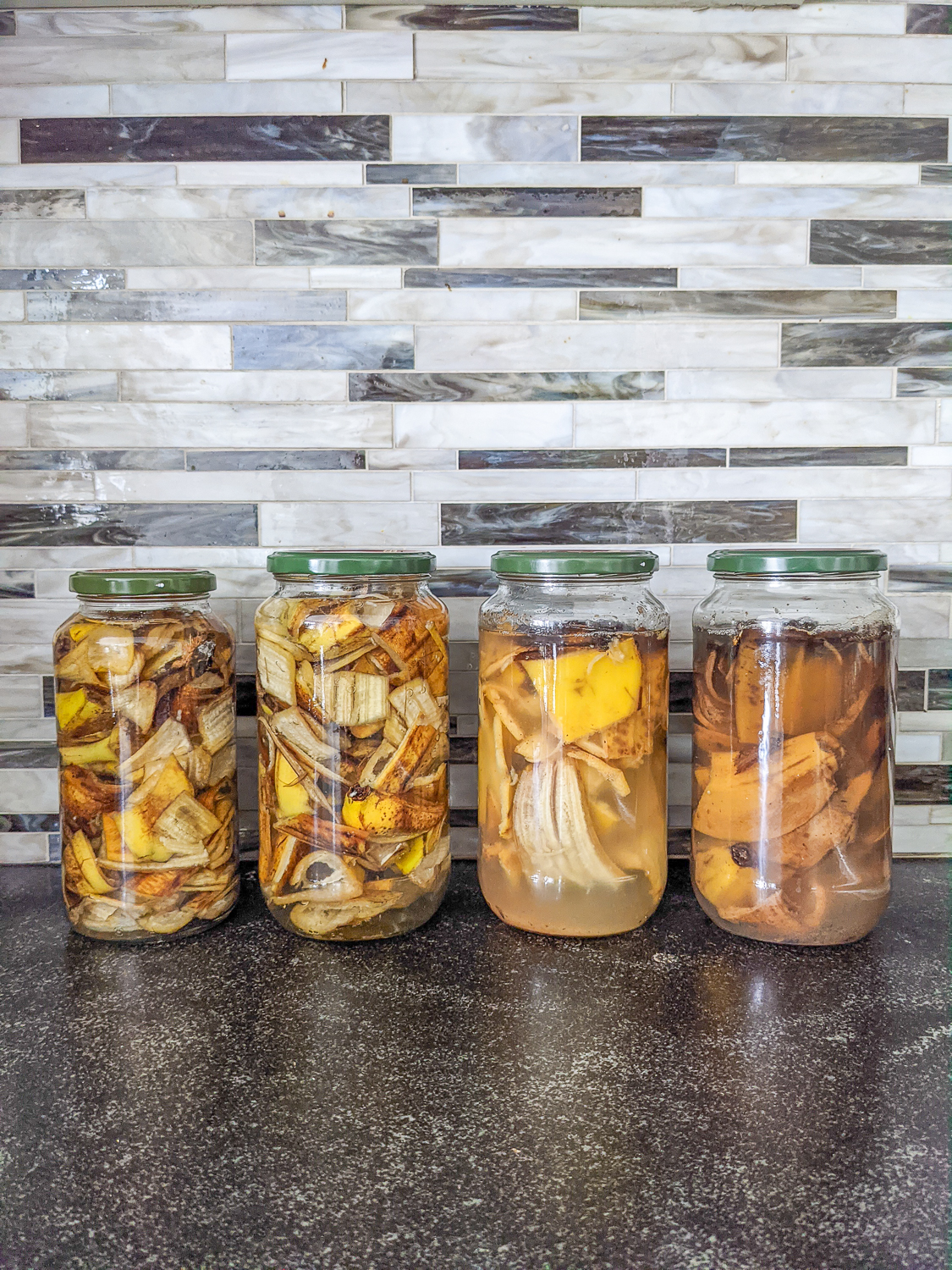
Plants Don’t Eat Bananas
Unlike humans, plants don’t eat bananas. Plants absorb nutrients from the soil and can only do so after complex nutrients are broken down by microbes and fungi into a form that is available to plants.
In order for plants to benefit from a potassium boost from banana peel tea fertilizer, the peel needs to breakdown such that the potassium becomes soluble in the water. If not, the potassium will remain in the banana peel that you end up removing from the jar and tossing into the compost pile.
In ideal conditions in a compost bin flush with oxygen, water, nitrogen, and carbon, we can speed up nature’s natural decomposition process. But the process to break down organic matter still takes at least a couple of weeks, and this is a best-case scenario.
We know from composting at home, that finished compost (that is ready to feed plants) takes months to decompose without sufficient air and active management. Why then would banana peels break down with abandon in an enclosed glass jar of water on my counter at room temperature in a few days into something suitable for plant absorption?
In other words, my rational (though admittedly not professorial-level) science brain doesn’t believe any sort of suitable decomposition happens in two days to a week… or even two weeks if we’re being generous. Thus, that smelly solution I served my plants was most likely just brown-tinted water with a spattering of rotting banana peel pieces attracting fungus gnats.
Fantastic! (Please tell me you can hear my sarcasm through the screen…)
Plants Prefer a Diverse Diet of Nutrients and Minerals
Plants need lots of different nutrients and minerals to survive and thrive. Variety is the spice of life. Nitrogen, phosphorus, and potassium are three of the main nutrients that are vital to their health and growth. However, different types of plants prefer varying levels of these (and other) nutrients in the soil.
Just for fun, let’s suppose our precarious banana peels could break down in two days to a week and create a liquid fertilizer lush with water-soluble potassium our plants will eat right up. Is banana peel compost tea fertilizer a complete nutrient solution?
Probably not. Bananas and banana peels are high in potassium, but they aren’t particularly loaded in nitrogen and all the other nutrients that plants need to grow. If the peels aren’t high in a variety of nutrients, they won’t provide those nutrients to plants. So your plants will probably need some additional, more complete fertilizer every once in a while.
Alternative conclusion… banana fertilizer compost tea is pointless (except when it causes fungus gnat infestations in your home, and then it’s straight-up annoying)!
I’m being a little dramatic, of course, by saying that it’s pointless. Some plants need a lot of potassium and might benefit from an occasional potassium punch in addition to general fertilization. But I don’t think banana peel compost tea, at least as seen on social media, is the answer.
Better Sources of Potassium Than Bananas
Aside from the fact that I’m not even sure banana peel compost tea actually works, bananas aren’t necessarily the best source of potassium. For example, a medium-sized baked potato has twice the amount of potassium as a medium-sized banana. A half-cup of pinto beans has about as much potassium as a banana. And papaya and prune juice can go toe-to-toe with a banana when competing over potassium levels.
Heck, why not butter up my succulent soil with baked potatoes and quench my plants’ thirst with prune juice?! Because it’s gross, and it attracts pesky bugs, just like banana peel compost tea. There’s more to life than a pile of potassium…
If Banana Peel Tea Fertilizer Doesn’t Work, What Other Organic Fertilizers Can I Use?
Compost. Compost. Compost.
I might be a tad bit biased. I’m a self-proclaimed compost nerd, after all. There are many ways to fertilize plants, including a variety of organic and natural options, but composting is queen. Compost is one of nature’s most effective methods for regenerating soil and recycling nutrients for renewed life.
We compost (in all the ways), so we use finished compost as a soil amendment in our garden and on our houseplants. Because finished compost is created from a variety of organic matter, it will naturally compromise a greater variety of nutrients for growing plants than a lone banana. If you have finished compost, that’s always a great way to feed your soil and help your plants flourish.
So What About The Banana Peel Tea Fertilizer?
Banana peel tea fertilizer is potentially a fun way to feed your outdoor plants. If you’re really keen to try it, at least consider aerated banana peel compost tea instead of soggy, brown banana peels drowning on your counter.
However, I have yet to see any decent research that shows banana peel compost tea being any more effective than traditional compost, aerated compost teas, or even water. If you have seen such research, I’d be stoked if you could link to it or share it in the comments. I’d love to read about it.
Honestly, I’m not sure I ever want to take the risk of introducing this in my home again. I’d much rather just compost all these banana peels. There are so many ways to compost at home. Even if you have a garden and no compost system, bury the banana peels in the soil outdoors before attracting pesky insects into your home with rotting fruit.
We’re still making lots of smoothies for breakfast, so I have a pile of banana peels each week that are way too good to waste. Ours will all end up in one of our compost bins. If you’ve successfully used banana peel fertilizer, I’d love to hear about your experience. I’m curious to know two things: 1) How did you make it without attracting annoying insects into your home? and 2) How do you know it actually worked?
Drop some knowledge on me while these fungus gnats are driving me bananas!

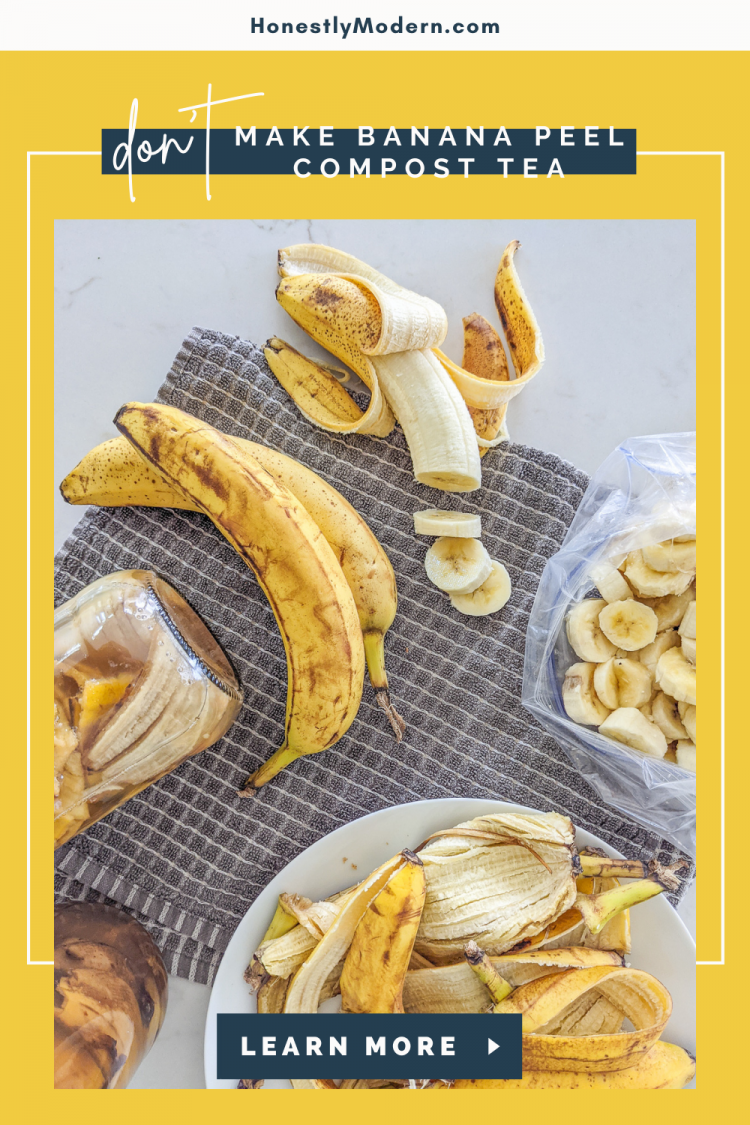
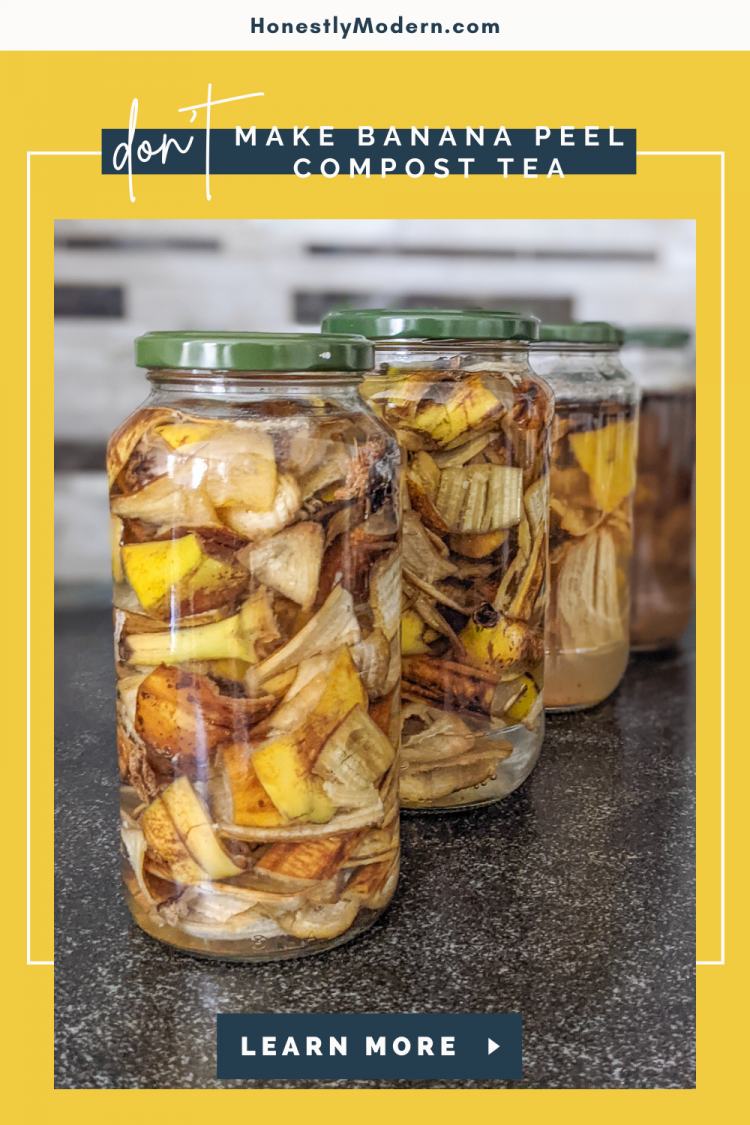
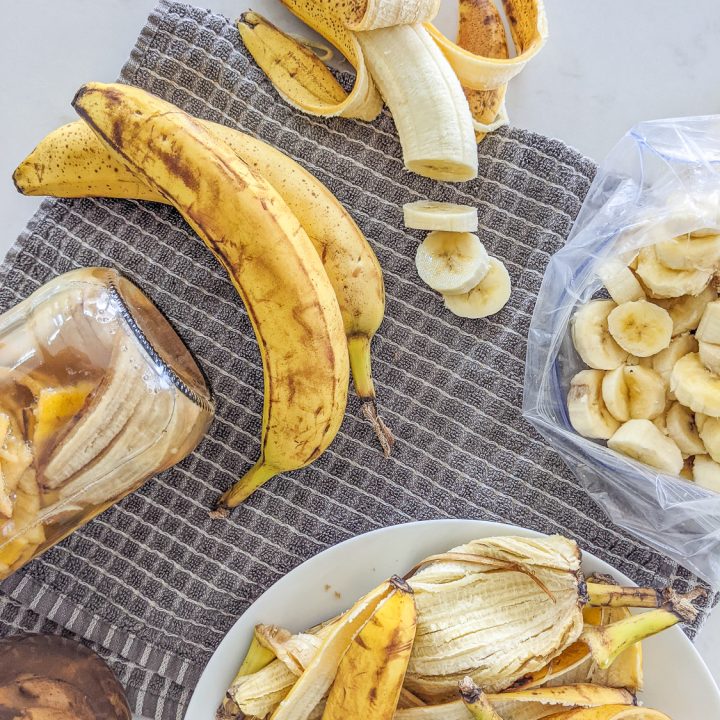
Banana Peel Compost Tea Fertilizer
Simple banana peel compost tea fertilizer that sounds fun but may not be what you expect. Banana peel lover beware.
Materials
- 3-4 banana peels
- Water - to fill the jar
Tools
- Quart-sized jar - we use repurposed pasta jars
Instructions
- Add banana peels to the jar.
- Fill the jar to the top with water, enough to cover the banana peels.
- Close the jar and allow it to rest for a few days or a week.
- Remove the peels and water plants with the banana peel tea fertilizer.
- Watch magic happen!

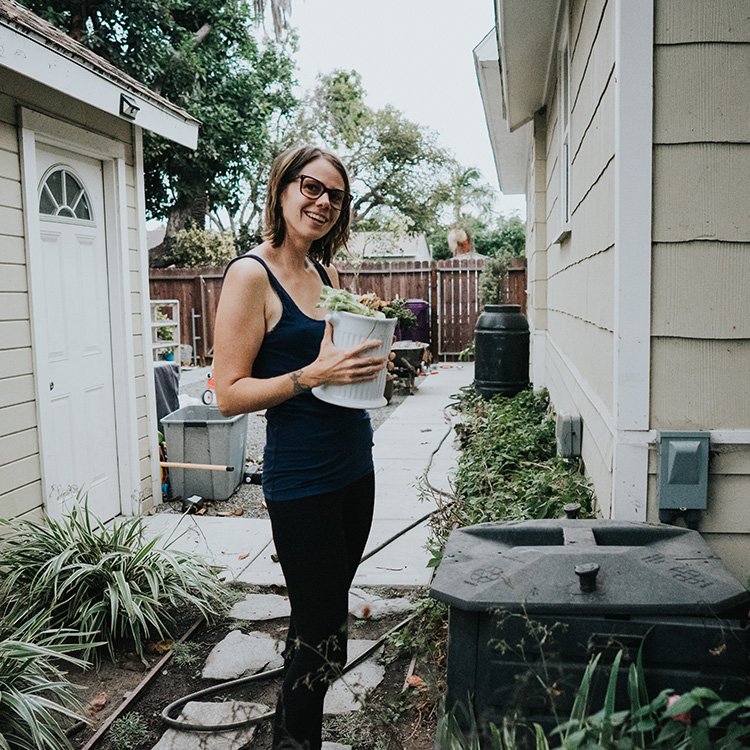
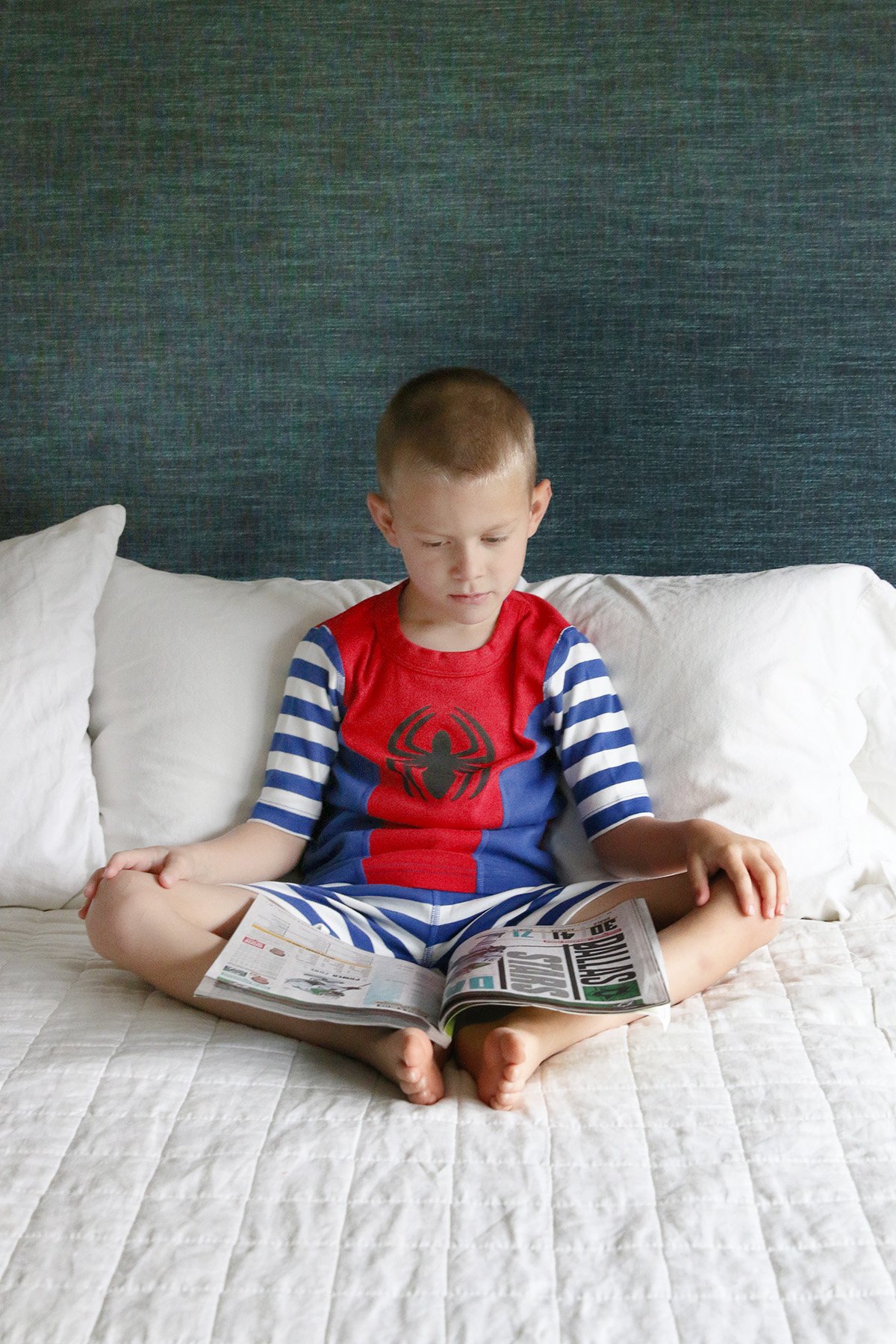
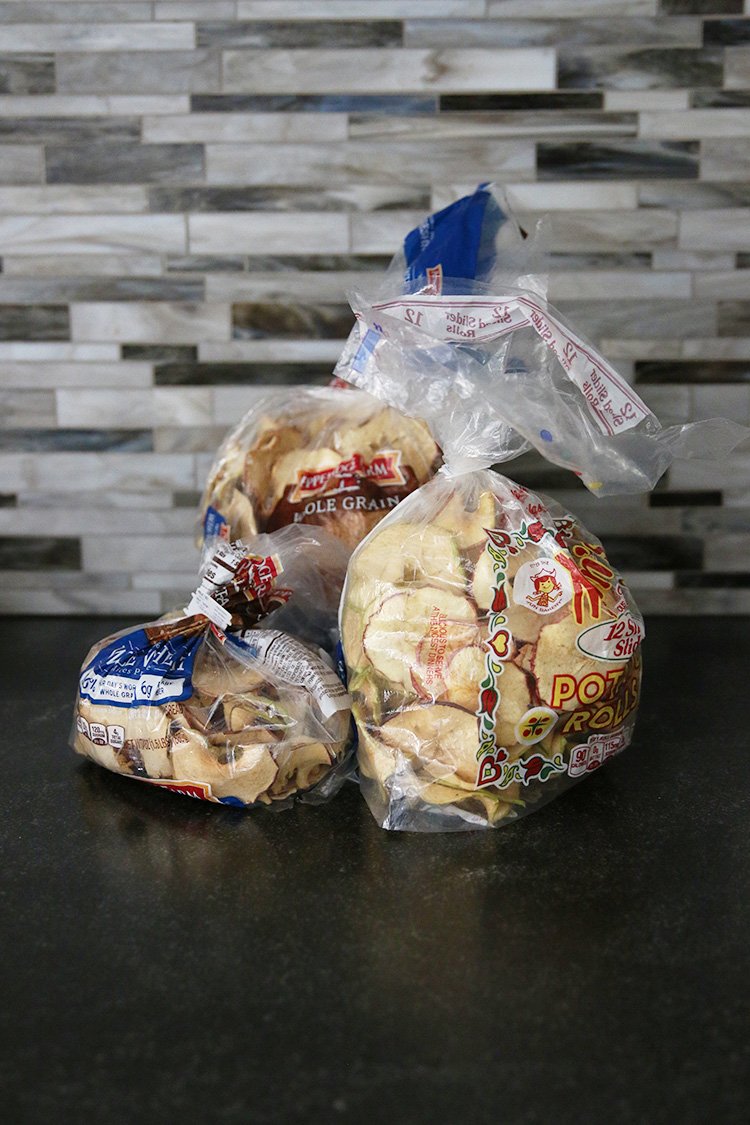
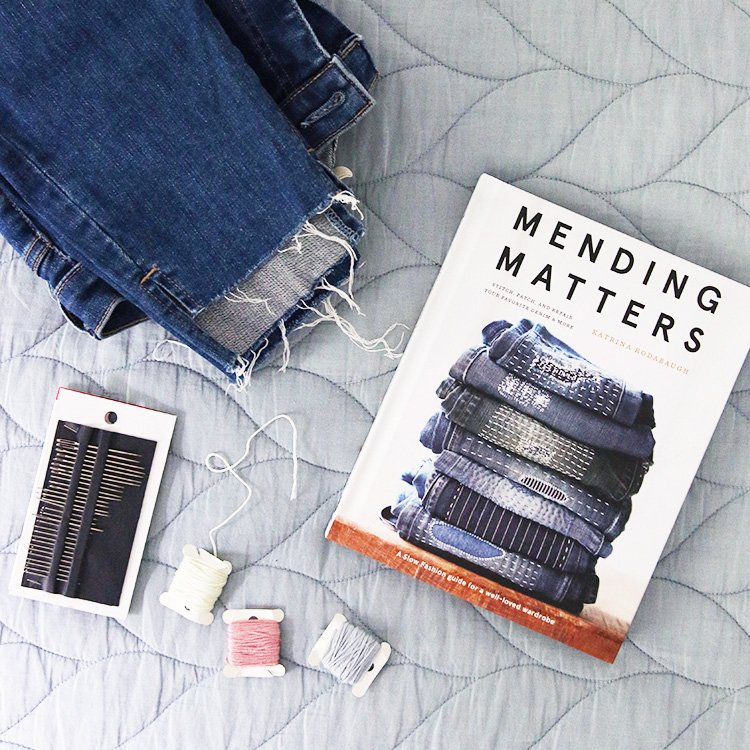
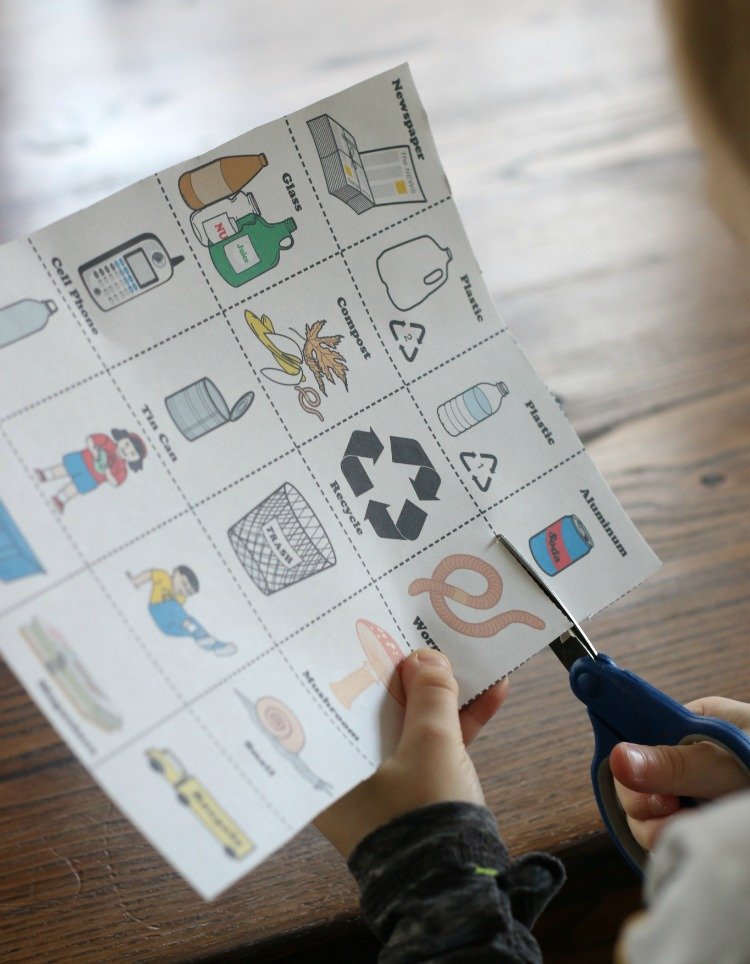
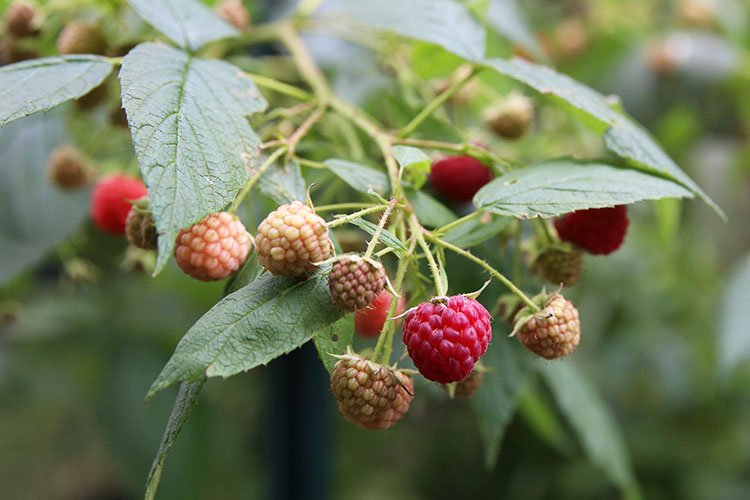

Did you filter it after? I always filter out pieces of food at least twice, and I also always use an environmental protection management product
I didn’t. I probably should have (ha). Do you have any recommendations for products you use to filter it? Also, what is an environmental protection management product? Thanks for your advice!
Ferment the banana peels with organic brown sugar just the same as fermented nettle extract use the same proces 2 weeks later .strain out the solids and dilute the tho I sticky syrup with water. That will eliminate all the anxieties of banana peel tea .and make a cleen and healthy useable feed.also you can mix seperate fermentation to make your own balance of npk.
Thanks for the note.
I have had success with this tea. First difference is that I put the peels in the oven on low heat until they dry out. Second I put them in a container, do not cover or seal, and pour boiling water over them. I like to mash the peels a little. You can use the tea as soon as cool and you can repeat the boiling water process.
Thanks for the tip!
Use bananas no feterlizer what so ever,and honey fresh from a friend,dilute both and strain out in36 – 48 hrs strain pour it into my 2 gal containers and mostly i use bananas from the mix for my start out growth and then starting flowering I do 1 watering with honey and water every other feeding then water then banana,air tight surrounding and at 1st ya had Nats but soil was a few years old after that never again and the taste is back I was getting pissed off everyone going for bag size and thc levels, just saying brother it works 4 me and I can’t go away from what works and do away with all the chemicals possible, old school lol,just say have great day brother.
To get rid of the fungus gnats… My husband put coffee grounds in my house plant and I was soon overloaded with the buggers. Water with a mixture of 50% hydrogen peroxide solution and water do this diligently for 3 weeks once a week. It doesn’t hurt your plants but it sure kills the fungus gnats
Thanks for the tip!
First – banana peel tea is NOT recommended for house plants; it is an outdoor fertilizer. Second, not only must you strain the tea, you also dilute it – you don’t use the tea full strength. Finally, the fact that banana peel tea does not provide ALL nutrients plants need is not proof that it provides NOTHING plants need. Although Potassium is the biggie, banana peel tea also contains some Phosphorus, minimal Nitrogen, Calcium, Magnesium, Manganese, and Sulfur. It also has some pest repellent properties against garden pests – outdoors, where there is adequate air circulation and the tea has been strained. I’ve used it for years with great results, especially for tomatoes, peppers, eggplant, and cucumbers – all heavy feeders – and for ornamental flowering plants. It’s also great for occasional watering of my container-grown perennial herbs which lose nutrients quickly in containers and which benefit from an occasional dose of a low nitrogen fertilizer. Depending on the need, I have also used the banana peel tea as the water component when diluting Epsom salt and fish emulsion for fertilizing – works great! Don’t give up on it yet.
Thanks for sharing all this information. 🙂
You shouldn’t use frozen pills ever use fresh peels chop them up put them in your water let it steep 24 hours in room temperature never store it in the fridge and never heat it up when you remove the pills the tea is concentrated so you need to dilute it considerably that’s the best way to use banana tea if it smells putrid do not use it at all this smells good enough to drink and then the plants will be happy that’s all I have been using it for years
I have clear plastic cups of clean dish soap and vinegar all around my house plants. Those pesty
Little gnats drown in it. I change the soap and vinegar water twice a week. I also microwave the potting soil, one soup bowl, wet soil, for around two minutes or until soil reaches 180f. Kills almost all the eggs and bugs that are in the soil. CR
Thanks for sharing!
Steinernema feltiae nematodes are the best cure I’ve found for fungus gnats. (I’ve gotten them frequently, unfortunately, since they tend to infest store-bought potting soil.)
Thank you for this tip!
Plain old garlic juice also clove will ridd you of fungus gnats .eventually
Just be persistent .also listen to the lectures on the Allan Chadwick archive living library .listen to them all and you will have a lifetime of knowledge at your disposal on every matter related to plants etc and also gain an insight into lifes finer matters.
Interesting. Thanks for sharing.
Hi, you can use matchsticks to get rid of fungus gnats – here’s an article that explains how:
https://www.askaprepper.com/why-you-should-place-matches-in-your-plant-pots/
Thanks for that idea!
Banana as a whole for a smoothie is better than peeled one. Forget peeled bananas and enjoy a smoothie with a full richness of these bananas.
I have never tried that. I’ll have to consider it. Thanks!
Only do this if they’re organic the ripening chemicals on most bananas are very harsh.
Well one way of fighting off many insects. Is diatomaceous earth. Unknown to many you can use diatomaceous earth in water. Spray your plants good but not dripping. When it dries it will help fight off pesky insects. You can also sprinkle some on the top soil. Nematodes will help inside the soil.
Thanks! I did end up trying the diatomaceous earth and it was helpful. I haven’t tried using it in water and spraying the plants. Thanks for the suggestion. I’ll have to look into nematodes as well.
The ratio used to perform the banana peel tea is wrong… 5 banana peels per plant (large sized plants on 5 gallon buckets) per 1 liter of water.
Filter it like you filter tea before drinking it or use coffee filter paper (takes time performs better).
Use neem oil to fix the fungus gnat issue. 2% neem oil emulsified with organic castille soap and per 1 liter of water. Apply on potting soil instead of watering the plants. Perform it 1 full month and bye bye fungus gnats…
Banana peel tea is usefull for heavy feeder edible producing plants like peppers, hot peppers, tomatoes, okras, etc. It helps on developing tons of flowers, fruits, and also on general plant health because of magnesium but gotta balance things with extra calcium otherwise you screw up the full nutrients balance (micro and macro). Mainly it’s only Phosphorous and potassium that is on the tea.
Pay it forward! 😉
And btw, forget the jars… Use a 2 liter plastic soda bottle, washed, rinsed and reuse it all the time! And keep the tea out of oxigen and light… You want a steeped tea not a full aerobic enviroment with all kinds of micro critters around… Otherwise you pay the full price of trying to be a pennysaver! 😛
Thanks for the information. I haven’t tried this way but it could be a useful alternative, though it does appear you’re using this on outdoor plants as you note large plants in 5-gallon buckets? I agree that would be a better idea. I appreciate the tips and hope they work for anyone who tries them! 🙂
Also, the tea should be diluted. 1:5 banana tea:water.
It could be because you used brown bananas or because of the long period of time the peels were sitting in the water. I heard a good way of getting rid of pests is neem oil.
Thanks! I’ll keep that in mind.
Just on a sidebar, my father was a farmer. He used human hair (obtained from his local barber shops and salons). He informed me that this makes the soil it’s in nitrogen rich. An additional benefit is that the human hair keeps many pests (squirrels, rabbits, etc.) away due to the “smell of humans”. He also used to plant snap beans and allow them to fall off the vine and rot. This increases the nitrogen on the soil naturally and exponentially! Hope this info is helpful pocus.
Agreed. Leaving it at room temperature for weeks is just a breeding ground for bacteria/fermentation. This is why everyone suggests to just let the peel sit in water over night or max a day. If they planned to leave it in a jar longer than that, then it should’ve went in the fridge.
Agreed, the natural sugars and yeast in the fruit will start to ferment over a period of time and turn into alcohol which is bad for any plant
After that , if the air can get to it it will turn into a vinegar also fatal for plants.
In my opinion, best to use the peel as a topping and water it in normally
Succulents for the most part don’t flower (unless they’re really mature). I use banana tea (banana peels and distilled water) for my outdoor calla lilies and hydrangeas to encourage blooms. Potassium encourages more blooms than a nitrogen-dominant fertilizer, which encourages foliage. Also I wouldn’t use brown banana peels because ripe bananas have way more sugar than say, a yellow banana. Banana tea really does work… for flowering plants, though.
That’s great that you use this for outdoor plants. I haven’t tried that yet (and I’m sure it’s better than on indoor plants). I tried it on some succulents and also on some flowering plants, but they were all indoors. Thanks for the tip on brown vs. yellow bananas. If I try this again sometime, I’ll keep that in mind.
I’ve been doing a lot of reading on banana compost tea. I heard that the success all starts with which bananas you use. Most people just buy bananas, but in the case of adding to your garden, you need organic bananas. Using bananas that have been treated with insecticide with surely kill your plants, starting at the root zone, so be careful! Carcinogens are found in the pesticides n will do damage to your plants.
Interesting. I hadn’t thought about that. Thanks for sharing.
I agree with John Doe. Most house plants are leafy and need nitrogen (plus other elements) rather than a lot of potassium. Bananas contain very little nitrogen, if any.
Also, you don’t mention diluting the mix, so may have been too strong for your plants. I will be using it on my tomatoes and chillies as they love potassium. So, a great idea, but maybe not for indoors!
Thanks for the note. Maybe I’ll try this on outdoor plants in the future. That seems to be a better solution. Also, I think that properly made banana compost tea (with aeration, proper tools, etc..) probably can be more effective. But I’m still skeptical about what I think are oversimplified methods that are getting popular on social media. Haha. Thanks for sharing your thoughts. More details and perspectives are definitely helpful.
Hi Jen, my name is Michelle. I’m not really a plant person but, I know how to get rid if gnats in your home. Get some Apple Cider Vinegar, pour some in a few small bowls or like dipping dishes… just a few Tbsp, then add about 1 Tbsp of dish soap to it DON’T STIR. Place these bowls where you notice the gnats in your home, but out of the way so they won’t get spilled. The gnats will be drawn to the sweet vinegar and killed by the soap. You may have to empty and refill a couple times, but they will die and collect in the dish… you’ll see. Good Luck!!
Thanks for this suggestion. I tried the ACV and that didn’t seem to attract them much. But I didn’t add dish soap. I appreciate the comment. – Jen
Never worked for me. I tried everything under the sun..those gnats still flying freely. Only thing that works I found by accident, a cup of ginger,/honey drink which I forgot on the table. The cup caught a lot of adult gnats. I placed cups of it in different rooms now.
Glad I’m not the only one – haha. Thanks for the tip.
I’ve found that putting apple cider vinegar, some dish soap and water in a glass jar (only about 1/4 to 1/3 full) with plastic wrap on top secured by a rubber band with holes poked in the plastic is the best way to get rid of gnats. They are drawn to the fermented smell of the ACV, they go through the hole to get in, the soap in the liquid traps them and they die. You can set up multiple jars since you have a bad infestation.
I think your results didn’t work because…well it wasn’t done right. 1) as you noted it should have been strained.
And 2) I have only seen that you are suppose to let it set a few hours. Not week! Obviously anything sitting that long when it’s already in a decomposing state will attach unwanted attention.
If I was you I would try again, but maybe let the plant that you experiment on stay outside in case you still run into a gnat problem.
Thanks for the note on this. I was primarily trying to replicate what I keep seeing on social media, so that’s correct that I didn’t strain it. Most posts don’t talk about that (though I agree I’m sure that would be helpful). As for only sitting for a few hours, I’d be surprised if that was enough time for the nutrients in the banana to break down and become water-soluble for the plants. But maybe it would work? Have you seen any science about this being any more effective than regular water? I’m still in search of it and have had no luck. I know there are certain types of compost tea that definitely work, I’m just not sure if bananas on a jar in a counter (for any length of time and even if strained) is the right answer. Thanks again for the note!
The info I read about banana fertilizer said it is meant for fruit and flowering plant not succulents.
Thanks for the note. You could be right that it’s better for certain types of plants than others.
Leaving the peels in an enclosed airtight jar creates anerobic conditions and undiluted /unstrained aslo compounds the matter. Aerobic conditions are what is required in all matters .
Agreed. Aerobic conditions make the most sense in most scenarios. 🙂
Hi Jen! When you said your plants don’t eat bananas, you’re right, but soil does. Little house plants don’t have enough soil to “digest” all that food, hence all your gnats having a feast. I use different compost teas, blackstrap molasses, and yes, banana peels outside. My roses LOVE banana peels under their mulch, and even banana tea. Try it on outside plants, potted or in the ground. If you ever want to feed your indoor plants, maybe add a tblsp of the tea to a gallon of water. Start from there and watch how the soil utilizes it. Good luck, happy plants start with happy soil.
Thank you Suzanne for this really helpful comment. I appreciate it. I may have to try this outdoors sometime. We have rose bushes as well.
I push the banana peels into the soil of the house plant pot around th plant and just water the pot Leto g banana peel slowly feed the soil feeding the plant
I just have to say there are much more variables to your problem you’ve experienced than what you’ve written to the world..
Firstly, succulents are plants that thrive with essentially little to no nutrients and or water in the soil.. Therefore your plants never even absorbed a majority of the water you put in them and when they did it was overloaded with potassium(which usually is only a necessary additive when you have fast growing or fruiting plants). This also is the main cause of your fungus gnats problem mostly because the soil was wet plus the rotting bananas created the perfect medium for a decomposing fungal growth which in turn attracted said gnats.
Banana compost does actually work wonders but it all depends on what your growing with it.
No worries though because with all things perfecting something takes lots of trial and error. Banana compost tea works wonders for that stubborn flowering plant that hasn’t grown in years and provides necessary carbs for microbes in the soil to feed on thus helping your roots and plant be stronger.
Hi Shaz – Thanks for the note. This is helpful. I agree there are more variables in here that I didn’t necessarily cover. I would love to see a true scientific experiment on this matter, but I’ve yet to find one. I also used it on plants other than succulents, and it didn’t seem to work well for those either (though again, not under a controlled scientific experiment). It seems like it might be an ok option for outdoor plants, though I think it needs to be made in a way that’s more specific and effective than the simple “let it sit in a jar for a few days” method that seems to be popular on social media (and the method I was intending to assess). I appreciate your comment. – Jen
Actually banana peel tea works great if you apply it to plants that need the extra potassium for fruiting and flowing plants.. I’ve been growing succulents for years and have never had to use any kind of fertilizer what so ever, or for any of my house plants for that matter. That’s probably why you had issues. Tomatoes and garden vegetables would benefit from this.
Thanks Jake. I used it on other plants too with not much luck. Also, I bet banana peel tea that’s made through a proper process works well. Do you have a recipe you like? I just am not quite sold that banana peels sitting in a jar for a few days breaks them down enough to do anything but maybe a more formal or involved process works better? Thanks for the note.
We dried up the peels, then made a tea using boiling water. Applied to some orchids – they literally exploded with flowers. I have never seen anything like it. And no gnats. But the orchids were in proper loose bark, not in soil.
That’s great to hear! Thanks so much for sharing that.
This is how you are supposed to do it.
You make a 1 liter of banana peel water.(1 liter to 3 bananas worth of peel.) By boiling it for just a few minutes then add 2 liters of water (reverse osmosis filtered)
Always PH balance your water to the range for your plants.
DO NOT ADD HOT WATER TO YOUR PLANTS.
You are supposed to dilute the tea in water. About a half cup per gallon of water. Use o
once per week.
Thanks for the note. Do you use the same recipe or do you use something else?
I normally blend my banana peel till it is liquified, no pieces of whole peels remain.
Aside from straining the peels from the water, I would also recommend only use 1 cup of banana water to 1 gallon of feeding water. This stuff is VERY diluted, so you need to use sparingly. Cheers!
Thanks for the recommendation. I appreciate it.
I’m going to give this a go for the outside, i’m just trying to hurry along some new grass I put down before it gets too cold. I’m going to boil them with some coffee grinds and strain into a sprayer
That’s great. I bet it will be great outdoors. Good luck.
It’s a supplement and not a replacement, for feeding your plants. It will actually give much nicer blooms and fruit if applied in early spring, and I also apply it to my grass every year after seeding with a backpack digger and it has made a noticeable difference in heartiness through the summer here in the south. Definitely not a one shot fix but beneficial IMHO
Thanks for sharing. Great to have perspectives from people with different experiences. I’ll keep this in mind.
Banana liquid fertilizer when used on well grown Rose plants,u will see flowering taking place a far more quicker
Thanks. It definitely sounds like using this outdoors is the way to go. And we have some roses, so I’ll have to try it next year. Thanks!
Not sure if anyone has mentioned it but you are supposed to boil the bananas in water for about 30-45 minutes to allow time for mineral leaching and then strain it out then let it sit for awhile. I thin k by just adding banana peels to water and letting it sit for as long as two weeks just made a jar of rotten banana water
Hmmm. I haven’t heard about boiling them. Wouldn’t that kill the good bacteria? But maybe it’s worth a shot. And I agree that just letting bananas sit in a jar seems to make for rotten bananas (which was kind of my critique on the oversimplified banana water tutorials I kept seeing on social media). Ha. Thanks for the note!
You should not b using banana liquid fertilizer or egg shell power specially for secculents. Well I can’t prove my point scientifically but I speak out of my personal experience. Six months ago I mixed home made egg shell powder to my well grown succulents. To my horror, the very next day, I saw healthy leaves falling apart n within few days my plant died. I learnt a lesson but the hard way.
Thanks for the tip.
When using eggshells one of the best aplications is to place the crushed shells in the root zone as they are ,crushed not powdered and if the plant needs the calcium it will engage it’s roots in extracting it (mild carbonic acid is made by the root to extract the goodness) most aplications require dilution as too much of one thing causes nutrient lockout either by a ph imbalance or by overabundance. Phosporus in inorganic form will throw outthe balance also. It’s all about b allance wether man applies it or nature.
I read lots of post about using banana peal tea. and while I was sceptical that it only needed a few days decided to give it a go. However lazy me wasn’t bothering with a little jar and set up a 40 L container no lid out in my vegetable garden and just added 2 to 3 peels a day and simply kept it topped up to the brim with rain water or from our well. After about 3 or 4 months decided to use the water didn’t bother to dilute and flooded my green beans with the water as they were yellowing and not growing as in previous years. I was surprised that 2 weeks later my bean were a normal green and flowering beautifully and lots of beans developing. Don’t know if it was just luck that they need an extra big drink or it actually worked. So am planning an experiment with another crop of beans and will water 1/2 with banana tea as above and leave the rest to nature and see what happens.
This is another good idea. I think if you leave it outside and it naturally gets some air it might work better than an airtight container without oxygen for the microorganisms in the compost tea. That’s great news about your beans! I’d love to hear how the experiment goes.
not sure if anyone has mentioned this yet but you are to use only 1 banana peel (not sure if you used more than one peel per jar). but most importantly you are to dilute the banana peel water before using with a 1:4 ratio which is probably why it wasn’t helpful for you.
Hello – Thanks for the note. I am sure some of those things might have helped. I’m still curious about why this type of compost tea (with no aeration over just a few days) would work. I’ll keep learning. Thanks!
Firstly…Succulents don’t like a lot of fertilizer, very mild fertilizer only about 2 times a year for most species. Since you didn’t dilute your banana mixture as others have mentioned you had a very strong solution which likely burned your succulent leaves and was too strong overall. You also left it soaking in the jar too long allowing it to actually ferment which may be why it attracted the gnats. Banana tea isn’t supposed to be a complete fertilizer, and brief research on sites like the father’s almanac and good housekeeping specifically say it is not a complete fertilizer.
Thanks for the feedback. Something to consider if I try this again.
Thanks to you and your commenters for the info. I’m intrigued, may have to give it a go. My comment is slightly off topic but…
I also have an abundance of banana peels. My favorite use is to cut them up and add them to my worm bin. Worms really seem to love them. Note: too much food in worm bin can also create a gnat friendly environment. I feel your pain.
My new favorite use involves putting them in the dehydrator (you can use your oven on lowest temp). After drying them I grind them, like I do with eggshells. These powders can be added to soil when planting things like tomatoes, potatoes and peppers. And they store nicely in empty cottage cheese type containers til I need them.
Glad this was helpful. And thanks for the tip about dedyrating. I’ll have to check it out. I do have a dehydrator. 🙂
I totally agree with Rob. Dried peels have no smell and won’t attract any pests. They also keep for a long time. I use them for two reasons: they are high in potassium, which is expensive to buy, and I love to find uses for what most people see as waste. I used to add to the compost, but some fruiting and flowering plants appreciate the extra hit of potash.
I started 2 jars, one covered with just a coffee filter, the other with the lid screwed on. The loosely covered gave a good result but the tightly covered one grew nasty mold so I think loosely covered is key. No gnat issues but I used the banana tea on a transplanted azalea and it’s blooming in no time now.
This post had me laughing out loud. Simply because I’m envisioning your zoom calls and gnat problems and it struck my funny bone reading that. It’s like a comedy skit.
Anyway I can relate to the gnats all too well. Call me lazy but I don’t always close my conditioner bottle in the shower. I used Joico hair conditioner in the past, which smells very sweet…the gnats were attracted to it so I would get gnats all over my conditioner bottle and it was so disgusting. The gnats get big too if they’re surviving in your house long enough.
In any case I’m glad I read this because I’m going to opt out of the banana peel method for my ficus. I’ll stick with my DynaGro fertilizer.
Best wishes
Haha. Glad it gave you a good laugh. 🙂
I’ve been using a banana tea for months now and have had good results.
1. 5 gallon bucket
2. 4 gallons of water
3. 2 or 3 banana peels, an orange peel, apple core, cucumber peels (whatever is fresh in the house)
4. Aerate for a couple of days uncovered
5. Pick out the large solids. I don’t strain it… little tiny pieces are fine unless they clog your sprayer.
I start with 30ppm RO water and end up with around 170+ppm tea. I use this as a base for additional nutrients and feeding. I think it’s an interesting alternative to using RO with CalMag as a base water for feeding plants. NOTE: this requires an Aerated infusion, not a closed jar.
Thanks Rick. I think this is a great way to make banana peel compost tea. I appreciate you sharing the recipe.
This tea is made for FLOWERING plants and only organic soil.
If your plants are not in flowering mode then this tea is overkill.
Tomatoes, peppers, and even cannabis will benefit greatly from this tea ONLY if they are currently blooming or fruiting.
And this feeds the microbes in you soil, NOT the plant. So unless you are an organic grower, dont use it.
Thanks. I think a banana compost tea that is properly aerated over several days might be great in the way you mentioned. Good information to have. Thanks for sharing.
Thanks for taking the time to write this up, was exactly the info I was looking for! Decided I won’t bother with the wet banana peels, my plant just needs soil with the full balance of nutrients anyway. Also! Super familiar with fungus gnats. Glad you solved that problem. I’ve found just not overwatering is enough to keep them at bay, but I can imagine that the huge infestation you experienced did better with that all-out push of the traps and the diatomaceous earth as well. If it ever comes up again (and hoping not!) we would spritz them with a slightly soapy spray, the surfactant messes them up a bit I think, and the plant doesn’t mind the little bit of potassium from the dish soap.
Thanks. Good to know. 🙂
You dehydrate the peels first then grind it into a powder. Mix the powder into the soil. No sweet smell, no bugs, just happy plants.
If you absolutely want to be extra safe after you grind into a powder put the powder back through the dehydrator for a few hours to make sure it’s all nice and completely dry.
Thanks for the tip.
The quickest most effective way to get rid of fungus gnats is to use Mosquito Bits, which are organic and non-toxic. You can even put the “bits”, the carrier for the substance that kills the gnats into the compost bin after you’ve soaked them in water. The secret, though, is to cover the plants with tulle or bug netting (Which is essentially just very low quality tulle, you can buy several yards for just a few dollars on Amazon. ) The gnats will fly to the top of the tulle where you can gather them up and dispose of them away from your home. It works much better than do sticky traps. Just don’t forget to repeat as directed to capture any gnats that hatch later. Also sprinkle cinnamon on the soil to kill or prevent fungus. Unfortunately, the tulle method doesn’t seem to work with fruit flies that live in drains. I guess they’re smarter than gnats. I was in the midst of brewing some banana peel tea when I came upon your article. The tips in the comments were very helpful. I did add other garden and kitchen scraps to my “brew” because I had recently read that one could extract nutrients from weeds by soaking them. I will add a pinch of humic acid to dechlorinate the water, as well as some kelp, and phosphorus. The tomatoes I overwinter are producing very tiny fruit. My reading indicates that a potassium boost might help. I have buried banana peelings in a Tomato plant before with a good, but not instantaneous result. I found that when I recycled the soil that the peelings were completely consumed by the soil organisms, and then, I assume, the tomato plant in just a few months.
Thanks for sharing.
Banana tea is popular because of the new popularity of cannabis growing. Cannabis growing is a supercharged process in most cases. In flower potassium needs weekly additives. So we add it where we can. The sugars also feed the beneficials and add brix. The method you described is meant to be used straight away. I would puree banana and aerate for 12 hours. Use immediately. Very diluted. Very strong. Using it straight is plant death via soil death. If you want to make alot and stop then you must ferment it. That will give you a few weeks. 5 banana peels will make enough 100 gal. If 1 gal of tea made. Fungus gnats were in the bananas. Very common produce comes w gnat eggs. The aeration and/or fermenting kills these. You could also use heat before making tea. Nematodes and need oil should already be in your soil. I got a store bought plant once that was infected and Infected my whole garden. Best advice is prevention but if you are swarming take this advice. Gnats go into soil and lay eggs. Larvae hatch and come out of the soil to mate. Rinse repeat. Short lifespan. Easy process to stop. Don’t let them in or out of the soil. With fabric containers I layer sand on top of soil. They can’t get through that. If planters have wholes at bottom then you can to bag them with screen. Guess you could fill pan w sand also. I don’t use plastic containers because the bottom trays are a source of alot of problems.
Thanks for the note. This is really helpful. I appreciate all the details.
I think you went wrong in two areas. First, I would not use this on indoor plants. Ever. And this is because I would have expected it to attract some bugs into the house. I only use this on outside, planted in the ground plants.
Second, you don’t use the banana peel tea right from the jar. You want to dilute it to a 4:1 ratio with fresh water. ie: 4 parts fresh water (can be tap water) to 1 part banana peel tea. Stir thoroughly and apply to the base of your outdoor plants.
Doing it this way, I have had nothing but great success for several years. Also, I only let my “tea” steep for about a week, never longer and I use distilled water to make my tea, not tap water. While I honestly don’t know if using distilled is any better than tap, this is how I learned, how I do it and how I get great results.
That’s great to hear that it worked for you. I agree that your suggestions are great and why the popular ‘social media hack’ version didn’t work. Haha. Thanks for the note.
I’ve actually found that you should always use tap water, because it also contains many elements that plants thrive on. I learned this from my father, who studied Botany in college. He was a farmer, as well. And just another tip. You can spread lime on your yard or garden. Grass will green up, but weeds can’t live if lime is spread (with a fertilizer spreader), both in the yard and the garden. And for the gnats, take a one-gallon jug filled about 8 ounces of banana tea or anything else that attracts them. After putting in the 8 ounces of tea, place a small funnel (duct taped brtween the funnel and the gallon jug) into the gallon jug with banana tea mixture. They can get in, but can’t get back out. Eco friendly!
Thank you for this very informative article. Thank you for addressing the issue from the pro and con points of view. I feel like you really took the time, to just present facts and made a very logical argument against using this particular type of Banana Peel Tea. I was almost ready to try this because it sounded cheap, natural, cool and was trendy. After reading this article I think I should stick with the science and only buy real fertilizer from a reputable source if I ever decide to use it.
Glad you found it helpful. There are lots of great compost teas (and some you can buy from reputable providers) but I do think banana peel compost tea is a bit more complicated. 🙂
Have you tried eating banana peels? I have read they work well in cakes and also curries! Though my daughter has strictly forbidden me from trying it! so tempted though!!!
I haven’t yet but I’ve heard about it. Very interesting. I think one person left a comment here that they put them in smoothies sometimes. I’ll have to give it a whirl. Thanks!
Thank you so much for sharing!
I actually love boiling my peels at bedtime for banana peel tea. This tea helps with my insomnia as well as my prescription pharmaceuticals
I have never heard of that. Thanks for sharing!
Hi Jen,
I’ve just stumbled upon your experiment and have a few suggestions. Over the many years of cultivating indoors I too have used the Banana Peel Tea method for my plants, but only when in the flowering stage. I agree it should be filtered of all solids before application and that an endless supply of basically “potassium” is not ideal or even beneficial to a healthy plant. But to counteract this I have always been told that a basic “MultiVitamin” tablet dissolved into 3ltr’s of water will more than supply a plant with the adequate nutrients for both vegetative and flowering stages. Have you ever tried using MultiVitamins ?
I haven’t tried that MultiVitamin solution, but thanks for sharing this and your other tips.
Hi Jen,
Since these insects loves moisture, I think this kind of fertilizer is not the best for you. You can try other organic fertilizers that has more nutrients than a banana can provide.
I also have an alternative for using banana as a fertilizer which involves drying them.
– cut the banana peels in smaller pieces so it will be easier to dry
– then spread them in a plate or tray and place them in a sunny area to dry for 4-5 days. it depends on your weather condition, I live in the tropics so it will dry in less than a week
– once it’s dry enough, use a mortar and pestle or a blended to break this down into salt like texture.
You can put this on the soil, 1 teaspoon for each plant every 15 days.
Personally, I prefer using Fish Amino Acid as fertiliser for my plants and Fermented Fruit Juice as my foliar spray. It Fermented Fruit Juice spray really helps my vegetables and fruit bearing plants to produce more flowers which means more yield.
Hope this helps.
Thanks for this! I really appreciate it.
Based on a bunch of guides I’ve read, I think the best way to utilize the potassium in banana peels is to dry them first and grind them into power before adding them to water. Dry them until they are completely brittle and snap like a chip when bent. You can do this on a hot day in direct sunlight and finish them off in the oven for a couple hours at about 160F if necessary. Then use a blender to grind them to dust then put them in a container and add water. I use about 5-6 peels worth of grounds in a 1 gallon jug of water and let that sit for a few days. Once a day I open the jug to release any gas build up then give it a good shake to reintroduce oxygen throughout the mix. The microbes need oxygen to break down the banana material or else undesirable microbes will takeover your tea in a low oxygen environment and ruin it(not a 100% on this part, but I did forget to burp and mix once and the tea turned into syrup; this also happens if you leave it in the jug too long). On about the third day the tea is ready to use.
Also, I think it’s possible to skip the fermenting step if you are using the tea on larger outdoor potted plants as they have more soil and naturally occurring microbes that will break down the banana material when added to the sol.
Thanks for sharing. These seem like great suggestions.
I loved this article. I am now not going to bother with this at all!
I have been a home owner for a year and the yard had not a tree or plant out back. I now have a double composter. I tend to just mess around and find out. But after reading this article- my compost is all I need. I’m not going to bother.
But fun fact- I found this article while researching after seeing a person keep their bathtub full of “banana water”. He says no bugs, and he drains it frequently.
Thanks for the note. And that’s quite interesting that he does that. Ha. Different strokes for different folks. 🙂 Glad it works for him. Love to hear that you’re composting!
I buy my organic fertilizer from the store. Based on what I have seen, I thought the banana peels needed to be boiled to help breakdown the banana peel. I don’t know if it works but some believe it does. I also keep my house plants outside because I am not trying to make a home for anything. You could kill fungus knots by pour boiling water over the soil. Of course you would have to remove the plant first and amend the soil afterward.
Hi Jen,
I have used banana peels water for quite some time but did not encountered the same problems. Also on the same fact to reduce food waste intention.
I suggest you to dilute your concentrated banana peels water into 1: 5 (water) part ratio before watering the plants.
If you throw in the concentrated banana peels water, it will definitely attract fungus gnat or ants.
Also after watering with the diluted banana peel water, if possible water with normal overnight tap water over the plant, just to wash down the banana water.
Hope that helps
Thanks for sharing!
Keep banana peels in a jar in the fridge for a couple days to a week,I don’t even cover it, strain out chunks and particles, rejar liquid only and dilute with water, 1 part tea, 10 parts water and spray on plants. Leftovers from straining can be set on a plate in the sun to dry out completely (turns black and crunchy) then put in a coffee grinder and ground up for top layer soil amendment. Great for flowering fruits and the like. All you did was create a huge mess, that kinda sucks but live and learn, have A great day.
How about drying the banana peels in the sun til they are completely brittle, then grinding them, then either mixing the ground peels in the soil or mixing it with water and watering the plants? Would that be bad for the plant?
Interesting suggestion. I hadn’t thought about it. I wonder if they would rehydrate when watering the plant. Worth an experiment maybe. Thanks for the suggestion.
No No & No
No jar no boiling no tea with banana
I uses small portion of fresh banana pill alone with mix of Bone meal & mix it with good soil .
Make a shallow hole all around plant & place it
The less is more= too potassium ( banana etc) will kill you plant due to being burned
& please don’t use pickle stuff like banana in jar NO !
2- tea does it apply to all plants , not all plants like nor require Magnesium. Some can actually stop growing due to magnesium. It depends on what kind of tea & hopefully you used cold/ room temperature tea just a little
Plenty of scientific research exists:
Bedhasa, T., Zekeria, Y., & Misrak, K. (2020). Production of Bioorganic Liquid Fertilizer from Coffee Ground and Banana Peels. Advanced Research Journal of Biotechnology, 4(4), 091-097. https://advancedscholarsjournals.org/journal/arjboa/articles/production-of-bioorganic-liquid-fertilizer-from-coffee-ground-and-banana-peels
El Barnossi, A., Moussaid, F. Z., Saghrouchni, H., Zoubi, B., & Iraqi Housseini, A. I. (2022). Tangerine, Pomegranate, and Banana Peels: A Promising Environmentally Friendly Bioorganic Fertilizers for Seed Germination and Cultivation of Pisum sativum L. Waste and Biomass Valorization, 13(8), 3611-3627. doi.org/10.1007/s12649-022-01743-8
Haji, K., Zekeria, Y., Misrak, K. (2020). Production of Bioorganic Liquid Fertilizer from Cow Manure and Banana Peels. Advanced Research Journal of Biotechnology, 4(5), 98-102. https://www.researchgate.net/publication/344338695
Hariyono, M., Ayunin, I. Q. (2021). Effectiveness of Banana Peel-Based Liquid Organic Fertilizer Application as Potassium Source for Eggplant (Solanum melongena L.) Growth and Yield. IOP Conference Series: Earth and Environmental Science, 752(1), 012022. doi.org/10.1088/1755-1315/752/1/012022
oi.org/10.1155/2022/7616452
Hussein, H. S., Shaarawy, H. H., Hussien, N. H., & Hawash, S. I. (2019). Preparation of nano-fertilizer blend from banana peels. Bulletin of the National Research Centre, 43(1), 26. doi.org/10.1186/s42269-019-0058-1
Kalemelawa, F., Nishihara, E., Endo, T., Ahmad, Z., Yeasmin, R., Tenywa, M. M., & Yamamoto, S. (2012). An evaluation of aerobic and anaerobic composting of banana peels treated with different inoculums for soil nutrient replenishment. Bioresource Technology, 126, 375-382. doi.org/10.1016/j.biortech.2012.04.030
Mercy, S., Mubsira Banu, S., & Jenifer, I. (2014). Application Of Different Fruit Peels Formulations As A Natural Fertilizer For Plant Growth. International Journal of Scientific & Technological Research, 3(1).
Thanks for sharing this.
Thanks for the article! I found the tip on social media as well and have been successful. I take the peels and boil on the stove top. Small daily batches and my houseplants are thriving. I water 2xs a week and they seem to like it.
Thanks for sharing how it has worked for you.
I had a nightmare with fungal gnats a few years back. After trying many options the only thing that worked was nematodes for the soil and the sticky fly papers for the ones still flying around.
Yeah – those helped me too. Diatomaceous Earth helped too.
Question:
I cut up organic banana peel and put in water in jars many years ago. and used the whole mixture under the soil around my roses – outdoors, of course. Not many years later – I still have a couple of jars full. Can I use this mixture outdoors or is it no longer of use as it has steeped so long?
thanks
I would think it’s past it’s prime if it’s that old. Though if you could put it in a compost bin, you might be able to put it in some empty soil and the microbes would take care of it. I’m not entirely sure.
I think, you soaked the banana peel too long. I just soak 24 to 48hrs to extract the nutrients, then spray the water and add the peel in my compost pile. No insect, bugs, no mess. Works fine for me.
Thanks for sharing your experience.
This article by Jen Panaro is a wake-up call for those of us who are tempted to try trendy DIY solutions without fully understanding their implications. Jen’s personal experience with banana peel compost tea fertilizer is not only relatable but also enlightening. Her honesty about the disappointing results and her cautionary tale about the simplified version of this trend found on social media are both refreshing and invaluable. This article has helped me realize the importance of thoroughly researching and understanding any DIY projects before jumping into them, and it’s a reminder to be cautious about blindly following popular trends. Great job on sharing your experience, Jen, and thank you for helping us avoid potential pitfalls in our gardening endeavors!